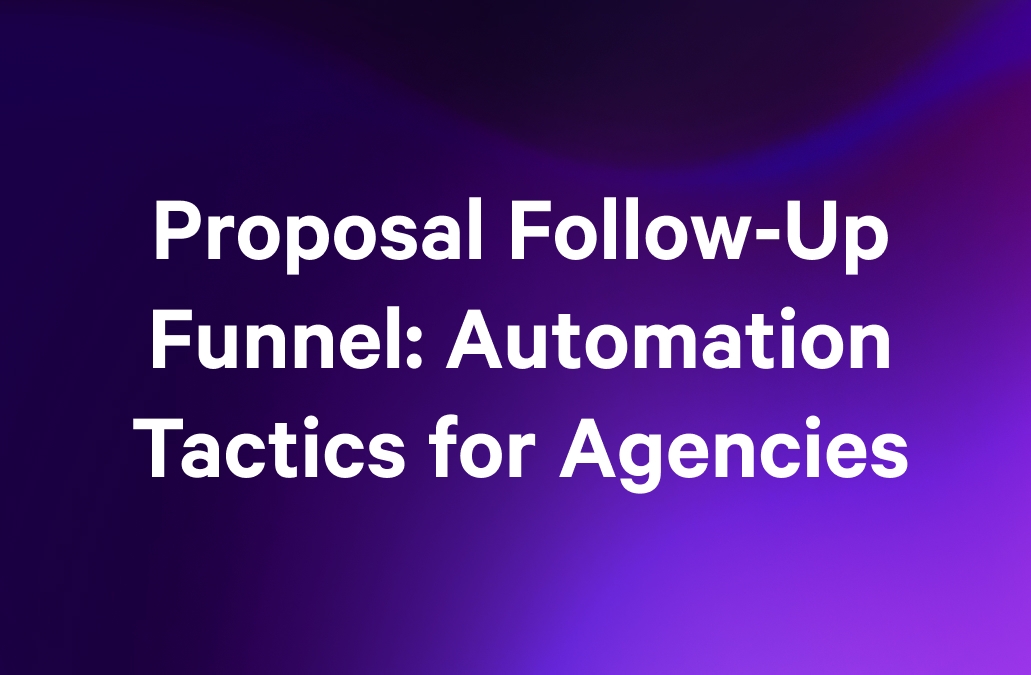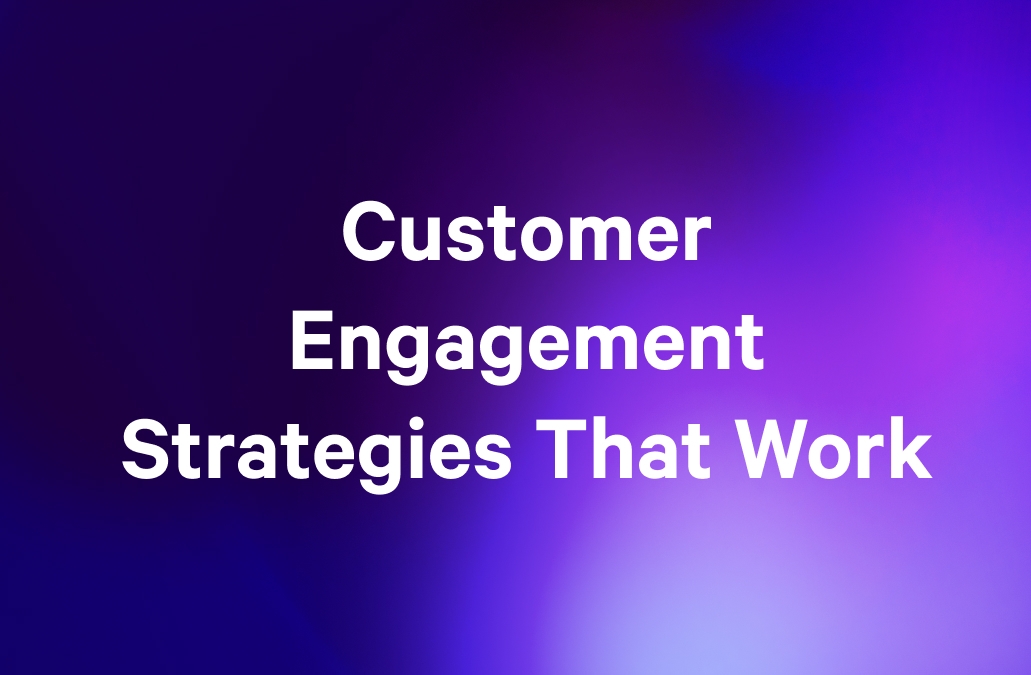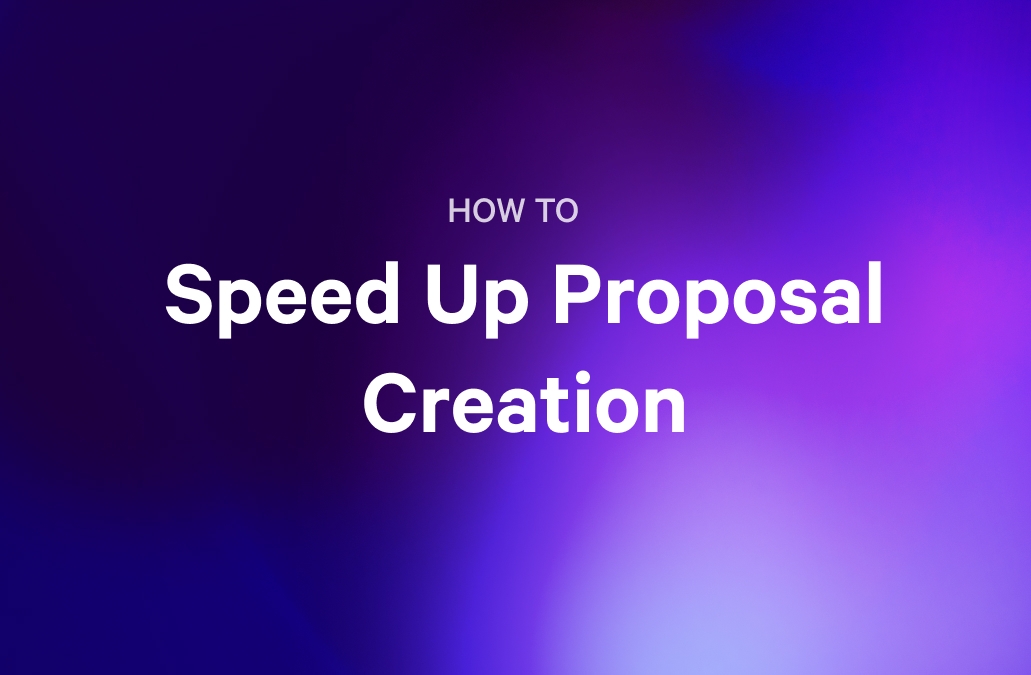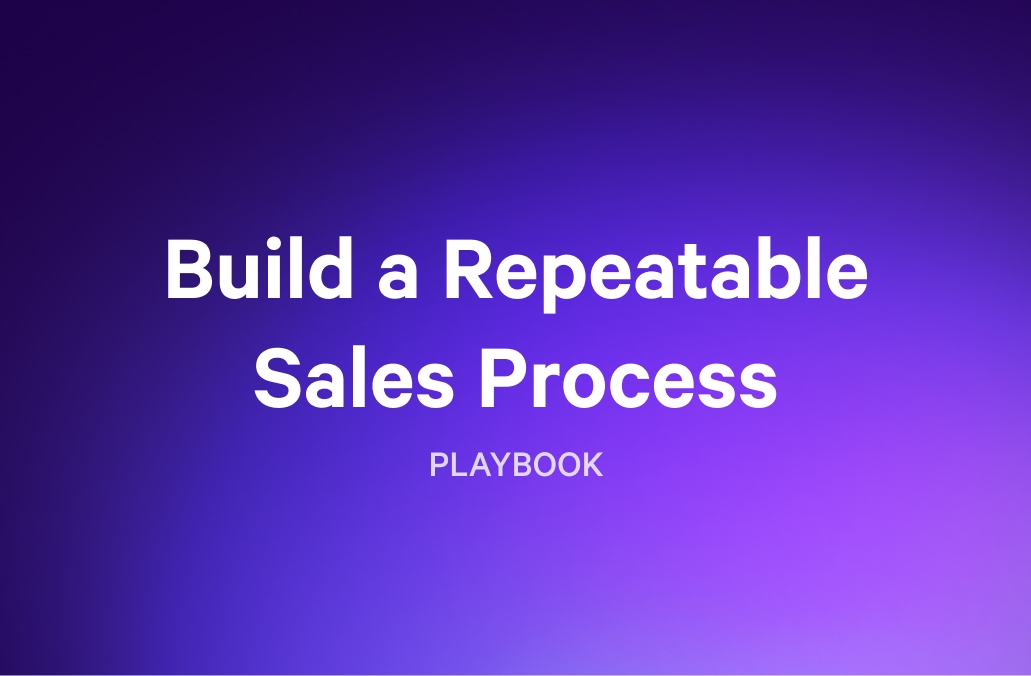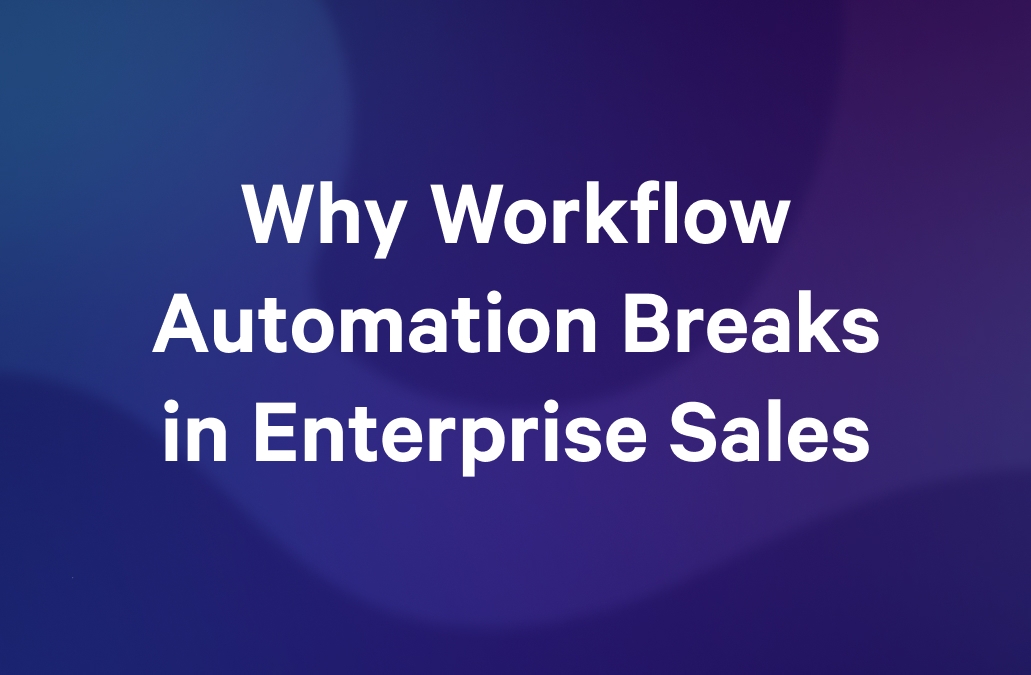In my early days of investment sales, I thought hustle was the whole game. Cold calls, quick pitches, non-stop meetings…you name it, and I did it all with naive passion (sigh!), thinking that if I pushed hard enough, the deals would come.
For a while, it worked.
But eventually, I hit a wall. The wins dried up, and every day felt like a reset. The more I pushed, the more obvious it became that I wasn’t losing because of the product. I was losing because I didn’t have a process.
Fast forward to today, and the stakes are even higher. Sales cycles are longer, buyers are more informed, and AI is rewriting how every stage of the process works. Which raises the question: Is your sales process built for the way buyers decide now, or are you still relying on hustle and hope?
In this article, we’ll unpack what sales process optimization really means today, how AI is changing the playbook, and five strategies sales teams can use right now to close deals with more consistency and confidence.
What is sales process optimization (and why it looks different now)
At its simplest, sales process optimization involves improving every stage of the sales process to run more efficiently and close more deals.
Traditionally, optimization was about efficiency — pipeline hygiene, standardized steps, and strict scripts, as the goal was predictability (reduce variation, shorten timelines, and move buyers from A to B).
That made sense when sales cycles were short and information was limited. But today, buyers show up with research already done, committees making the call, and expectations shaped by personalised digital experiences. A rep who once ran a generic demo and emailed a PDF proposal now needs a process that adapts to multiple roles, longer cycles, and shifting objections.
Here’s how the difference looks in practice:
| Sales Stage | Traditional Approach | Modern Approach |
|---|---|---|
Lead capture | Manual list-building, cold calls, generic openers | ICP-driven targeting with signals, AI-assisted research to personalise outreach |
Discovery | Fixed script, minimal prep, qualify-and-move-on mindset | Buyer-journey discovery: validate pain, map stakeholders, capture risks (AI summaries) |
Demo | One-size-fits-all presentation | Modular demo paths aligned to roles, recorded clips for async stakeholders |
Social proof | One generic case study emailed | Role-relevant proof packs with tailored metrics, tracked for engagement |
Proposal | Static PDF with fixed pricing, manual follow-ups | Trackable proposal with options, mutual action plan, automated reminders |
Negotiation & approval | Endless email threads, version chaos, buyer committee delays | Structured concessions, stakeholder-specific summaries, streamlined sign-off |
Close & handover | Signed doc by email, rushed transition | E-signature, instant provisioning, clear success plan, and outcomes |
As Scott Moss of M Sales Growth Advisors puts it:
“Look, if you want to actually grow your business, you have to stop thinking about how great your product is and start thinking about how much of an impact your product can have on a potential client.”
That mindset shift captures why optimization now means more than just tightening the funnel, but rather aligning the process with how buyers truly make decisions.
Why sales process optimization matters
Now that you understand how sales processes have evolved from rigid scripts to flexible, buyer-first systems, let's examine why this optimization delivers measurable results in today's competitive landscape.
Faster cycles
- 2-5% sales increase from optimization
McKinsey's global survey of 2,500 B2B companies found that leaders in sales process optimization drive a 2-5% sales increase through data-driven decision-making and systematic process improvements.
Higher close rates
- 2.5x more likely to be top performers
Gartner research finds organizations with action-centered insight and design and using data-driven understanding of seller actions—are 2.5x more likely to be among top sales organizations.
Increased productivity
- 20-30% productivity improvement
McKinsey research shows companies with world-class sales operations can realize one-time improvements of 20-30% in sales productivity, with sustained annual increases of 5-10%.
Better buyer experience
- 1.4x more likely to exceed revenue goals
Deloitte research shows B2B organizations using Revenue Operations which emphasizes alignment and end-to-end process optimization were significantly more likely to exceed revenue goals by 10% or more.
The numbers speak for themselves—organizations that thrive view sales process optimization as an ongoing capability, not a one-time project. This is whether it involves streamlining the proposal stage, where deals often stall, automating repetitive qualification tasks that drain rep time, or redesigning territory coverage to match actual buyer behavior.
So the question is, how do you turn those principles into a practical playbook your team can use every day?
The modern playbook for sales process optimization
If this is the part you scrolled for, we get it. What follows are five plays built to tackle the roadblocks you’re probably feeling right now, such as messy handoffs, longer cycles, and buyers who ghost.
Play 1: Map stages to buyer decisions, not your process
Most CRMs force you to track where deals are in your process (discovery, demo, proposal). But buyers don't move through your process; but move through their own decision-making journey.
Mark Kosoglow proved this approach works at scale. As former SVP of Outreach, he built a five-stage sales process that scaled the company from $0 to $250M ARR by asking one simple question: "What does the buyer need to agree on to move forward?"
Instead of stages like "Discovery → Demo → Proposal," Kosoglow's framework focused on buyer agreements:
- Problem Agreement → Do they acknowledge a problem we can solve?
- Priority Agreement → Is solving this problem worth the investment now?
- Evaluation Agreement → How will they decide between options?
- Value Agreement → Do they believe we can deliver the claimed results?
- Commercial Agreement → Is the solution worth the price?
These agreements can happen in any order. A small deal might compress them into one call; an enterprise deal might cycle through them multiple times as stakeholders enter. The breakthrough isn’t the number of stages; it’s that exit criteria are based on buyer proof, not seller activity.
The image below shows Kosoglow’s five stages in action. Notice how each one is framed around what the buyer must agree on, not what the rep logs in the CRM.
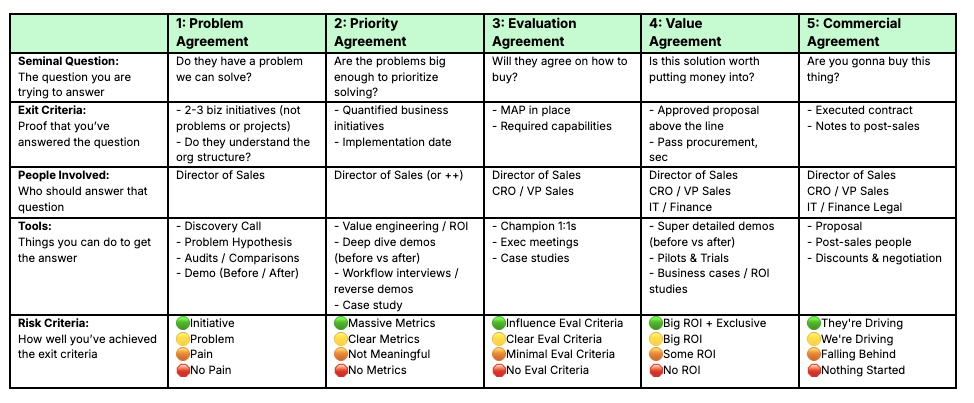
This video shows Kosoglow's exact framework and how it scales from 30-minute calls to complex enterprise deals:
TL;DW
- Meeting-based sales is broken: Traditional processes focus on seller activities (discovery call, demo call) rather than buyer decisions, creating rigid, inefficient cycles
- Stage-based process = Buyer decisions: Focus on five key agreements that buyers must make, which can happen in any order or meeting
- Compress or extend based on deal size: Small deals can fit all five agreements into one 30-minute call; larger deals may require multiple calls per stage
- Exit criteria matter more than activities: Don't advance until you have clear proof of agreement (quantified business impact, timeline) not just "they seem interested"
- Tools serve agreements, not vice versa: Use proposals, demos, or pilots at any stage to test for genuine agreement rather than following a rigid meeting sequence
And here’s where AI can make this even sharper: real-time data and intent signals help you see which buyer agreement is closest to being reached, so you don’t push the wrong stage. Bain’s recent report shows that when AI is built into core sales workflow (not just bolted-on), win rates can improve by 30% or more.
Play 2: Embed automation and AI where it removes friction
Sales reps spend just 28% of their week actually selling, according to Salesforce's State of Sales report. The other 70% gets consumed by administrative tasks, data entry, research, and internal meetings.
The solution isn't hiring more reps or working longer hours. It's systematically removing the friction that keeps reps away from buyers. This is where AI delivers immediate impact.
As Nathan Clark from UpGuard says, "Don't do new things and plug in AI. Work out what you're doing already and ask where it can be more efficient."
Below are four ways we found from our webinar with HubSpot and UpGuard on AI in sales that actually move the needle.
- Call notes and follow-up - Auto-generates summaries and action items instead of 20 minutes of manual work per call
- Email personalization - Creates tailored outreach based on LinkedIn posts and company data rather than generic sequences
- Product knowledge - As Marina from HubSpot notes, "There's just so much information and I don't have time to Google search everything on a demo"
- Proposal creation - Transforms hours of content work into minutes of refinement
Take, for example, Qwilr's AI proposal builder that lets sales teams create stand-out, on-brand proposals in minutes. Reps can add videos, dynamic pricing cards, ROI calculators, and more without the usual design and formatting headaches, saving them hours.
In essence, AI doesn't need to be perfect to be transformational. It just needs to remove enough friction that reps focus on what actually closes deals.
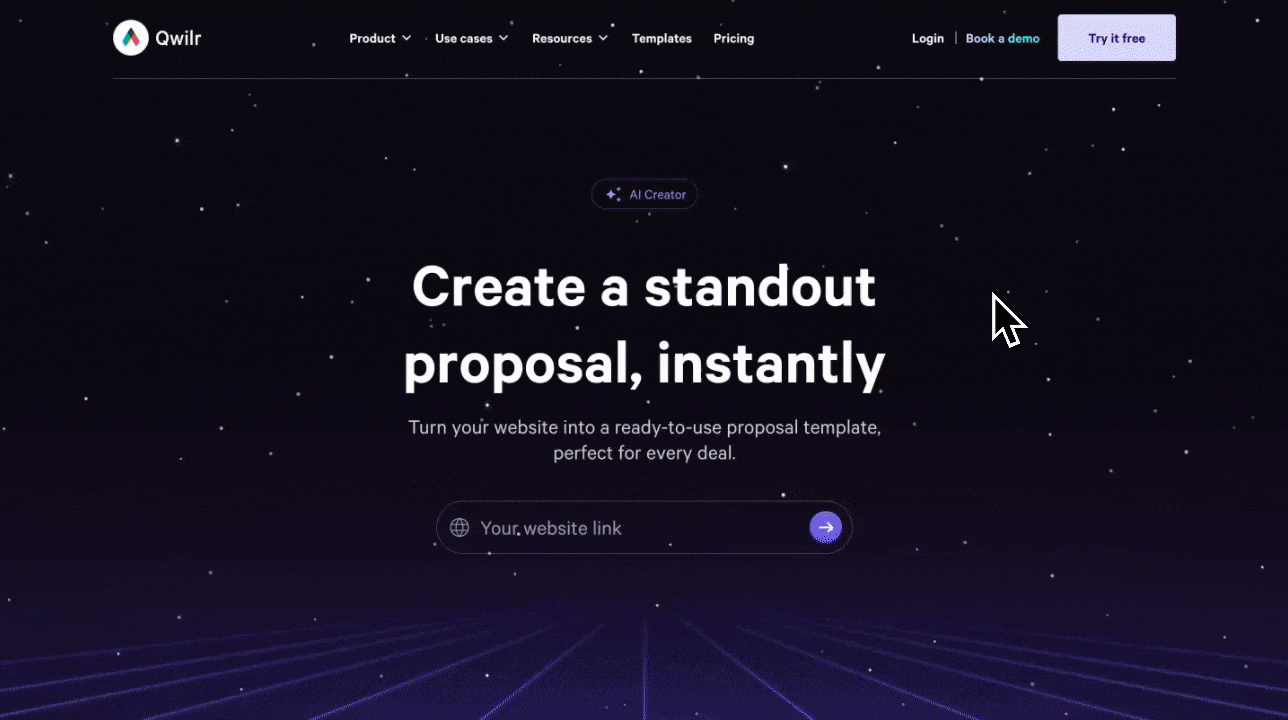
Play 3: Optimize handoffs across the funnel
Handoffs are where deals most often stall. A buyer shares their challenges with an SDR, only to repeat them to an AE. A deal closes, but customer success discovers promises they can’t deliver. Every missed detail adds friction, and friction is the enemy of optimization.
Why does this matter? Because every broken handoff drags out the cycle. Repeated questions make buyers doubt your professionalism. Lost context forces teams to rework. Multiply that by dozens of deals a quarter, and the inefficiency compounds fast.
Optimization here means designing handoffs that:
- Preserve momentum → buyers never feel like they’re starting over
- Protect context → no information lost between teams
- Boost conversion → fewer leads dropping at stage changes
The difference can be dramatic. LaunchNotes, a SaaS company, once stitched proposals together using PDFs, HelloSign, and Notion. The process created version headaches and made it hard for sales and customer success to stay aligned. By consolidating into a single interactive workflow, they cut five manual steps, eliminated version chaos, and ultimately doubled their close rate.
Or as their sales manager, Blake Ziolkowski put it:
“It removes five steps in the sales process and makes it much easier for everyone.”
The takeaway here is that optimization isn’t about adding more processes, but making every transition cleaner so deals keep their momentum. And today, AI can help here too by automatically syncing notes, updating CRMs, and carrying buyer context across every stage so nothing slips through the cracks.
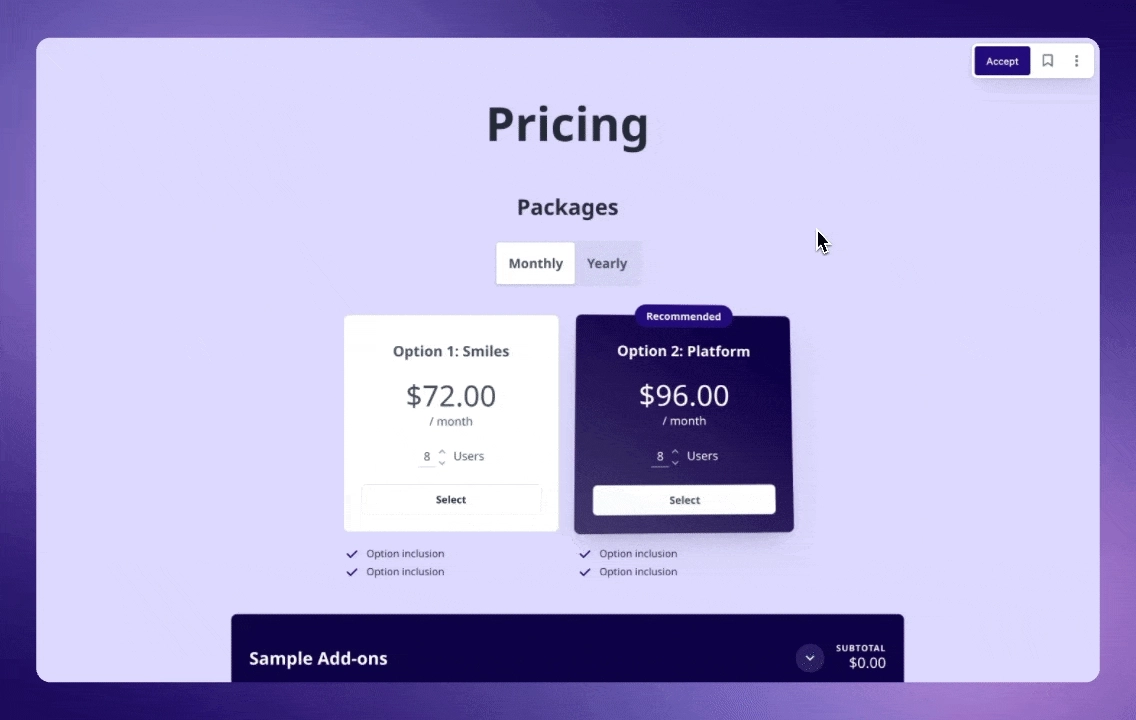
Play 4: Turn every deal into data for the next one
Most sales teams celebrate the close, commiserate over the rejection, then move on without capturing what actually worked or why things fell apart. That’s optimization malpractice.
Every conversation, proposal, and objection contains intelligence about your process. The teams that consistently hit quota extract insights from every interaction and feed them back into their approach.
Plenty of products now come with built-in automation (like Qwilr’s proposal analytics that track engagement). But that only tells you what happened. Here’s where reps and leaders can go further using external tools like ChatGPT and Claude to turn raw deal data into practical next steps.
- Deal analysis: Copy CRM notes from a stalled deal into ChatGPT and ask, “What’s missing from this discovery? What questions should I have asked?”
- Call debriefs: Paste call summaries into Claude with, “This deal hasn’t moved in three weeks. What are three specific actions I should take?”
- Proposal reviews: Before sending, ask ChatGPT, “What objections might their CFO raise, and how should I address them proactively?”
- Coaching: Managers can paste rep call notes into Claude and ask, “What coaching points should I focus on? Give me three specific areas.”
Instead of waiting for quarterly reviews to spot patterns, you’re analyzing every deal as it happens. That’s how sales AI makes optimization continuous, capturing lessons in real time and tightening the loop between today’s deal and tomorrow’s win.
Metrics that prove your sales process optimization is working
All the process tweaking in the world means nothing without numbers to back it up. Sales optimization without measurement is just expensive guessing. The question isn't whether to track metrics, but which ones actually tell you if your changes are working.
| Metric | What to track | Good | Great | Why it matters |
|---|---|---|---|---|
Sales Cycle Length | Average days from first contact to close | 15% reduction year-over-year | Consistent shortening across all deal sizes | Shows if process changes accelerate deals or just shuffle paperwork |
Win/Loss Rates by Stage | Conversion rates between each sales stage | 60% qualification-to-proposal conversion | Identifying exactly where deals die | Generic win rates hide problems; stage-by-stage rates expose them |
Rep Productivity | Percentage of time in customer-facing activities | 40% selling time (vs 28% industry avg) | Month-over-month improvement | If optimization isn’t freeing up selling time, it’s not optimization |
Proposal Engagement | Views, time on page, stakeholder involvement | 3+ stakeholders viewing proposals | Real-time alerts on engagement changes | Traditional metrics track opens; modern metrics track intent |
Forecast Accuracy | Predicted vs actual close dates/amounts | 80% accuracy within one month | Improving accuracy quarter-over-quarter | Bad forecasts usually mean bad process discipline |
Track these consistently, and patterns emerge. Ignore them, and optimization becomes just another initiative that fades after the next quarterly planning cycle.
Start building your optimization engine
Sales process optimization isn’t about one big change; it’s about small improvements that compound with every cycle, deal after deal. Tighten one stage, and the cycles move faster. Remove one layer of friction and reps get hours back. Align with buyer decisions, and close rates rise. The sooner you start tightening the system, the sooner you see results that stick.
And when it comes to tightening, proposals are one of the best places to start. They’re often where deals stall, but they can just as easily become the moment momentum builds.
That’s where Qwilr comes in, transforming proposals from static PDFs into interactive experiences that compress deal cycles, track buyer intent, and help teams close with confidence.
Ready to see how we can help your sales process accelerate? Start a free trial today and start turning proposals into your team’s competitive edge.
About the author

Taru Bhargava|Content Strategist & Marketer
Taru is a content strategist and marketer with over 15 years of experience working with global startups, scale-ups, and agencies. Through taru&co., she combines her expert skills in content strategy, brand management, and SEO to drive more high-intent organic traffic for ambitious brands. When she’s not working, she’s busy raising two tiny dragons. She's on a first-name basis with Mindy Kaling.
